人教版九年级英语Unit8-It-must-belong-to-Carla教材全解加课后练习附答案
- 格式:doc
- 大小:407.50 KB
- 文档页数:8

Unit 8 It must belong to Carla.一、教学目标:1. 语言知识目标:掌握本单元重要词汇、短语与句型。
提高学生的听说读写等方面的技能,以及这些技能的综合运用。
2. 过程与方法:听说读写训练,通过自主学习,小组合作探究等多种方式充分调动学生的学习积极性。
3. 情感态度价值观目标:面对身边暂时不可解释的现象,根据已有证据进行合理推测,不信谣,不传谣。
二、教材分析本单元开始以野餐中谈论对事物的推测为话题引入本单元的教学重点:情态动词表推测。
情态动词是一种重要的词法,只有掌握好它,才能更好的进行交际和阅读。
本单元通过学习用相关信息对物主的推测来提高学生的逻辑思维能力和推断能力。
教学重点:情态动词must, can’t, may, might, could表推测。
教学难点:如何灵活运用must, can’t, may, might, could表推测。
三、学情分析通过初中两年的英语学习,大多数学生已能听懂有关熟悉话题的语段和简短的故事,能就熟悉的话题交换信息,能读懂短篇故事,能写便条和简单的书信。
但由于各种因素的影响,学生发展参差不齐。
少数学生因为基础不够好,学习很吃力而自暴自弃,学生两级分化严重,每节授课内容不宜过多,用多种教学手段充分调动学生的学习兴趣。
四、教学策略采用任务型语言教学,实施情境教学法、小组合作探究法、情感激励法。
五、教学手段:多媒体辅助六、课时安排:第一课时:Section A 1a-2d第二课时:Section A 3a-4c第三课时:Section B 1a-1d第四课时:Section B 2a- 3b英语学科授课时间任课教师课题Unit 8 It must belong to Carla.Period 1(1a--2d)三维教学目标课标要求: 能听懂有关熟悉话题的谈话,并能从中提取信息和观点。
能针对所听语段的内容记录简单信息。
能与他人沟通信息,合作完成任务。
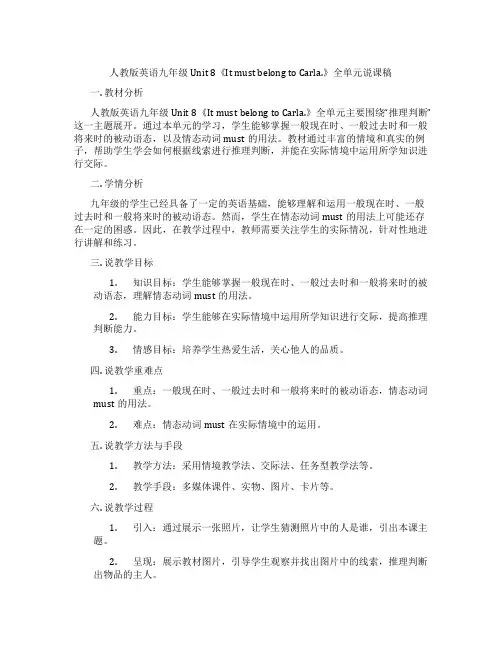
人教版英语九年级Unit 8《It must belong to Carla.》全单元说课稿一. 教材分析人教版英语九年级Unit 8《It must belong to Carla.》全单元主要围绕“推理判断”这一主题展开。
通过本单元的学习,学生能够掌握一般现在时、一般过去时和一般将来时的被动语态,以及情态动词must的用法。
教材通过丰富的情境和真实的例子,帮助学生学会如何根据线索进行推理判断,并能在实际情境中运用所学知识进行交际。
二. 学情分析九年级的学生已经具备了一定的英语基础,能够理解和运用一般现在时、一般过去时和一般将来时的被动语态。
然而,学生在情态动词must的用法上可能还存在一定的困惑。
因此,在教学过程中,教师需要关注学生的实际情况,针对性地进行讲解和练习。
三. 说教学目标1.知识目标:学生能够掌握一般现在时、一般过去时和一般将来时的被动语态,理解情态动词must的用法。
2.能力目标:学生能够在实际情境中运用所学知识进行交际,提高推理判断能力。
3.情感目标:培养学生热爱生活,关心他人的品质。
四. 说教学重难点1.重点:一般现在时、一般过去时和一般将来时的被动语态,情态动词must的用法。
2.难点:情态动词must在实际情境中的运用。
五. 说教学方法与手段1.教学方法:采用情境教学法、交际法、任务型教学法等。
2.教学手段:多媒体课件、实物、图片、卡片等。
六. 说教学过程1.引入:通过展示一张照片,让学生猜测照片中的人是谁,引出本课主题。
2.呈现:展示教材图片,引导学生观察并找出图片中的线索,推理判断出物品的主人。
3.讲解:讲解一般现在时、一般过去时和一般将来时的被动语态,情态动词must的用法。
4.练习:学生分组进行角色扮演,运用所学知识进行交际。
5.巩固:学生完成教材练习题,检测所学知识。
6.拓展:引导学生运用所学知识,谈论现实生活中的人和事。
七. 说板书设计板书设计需突出本课重点内容,包括一般现在时、一般过去时和一般将来时的被动语态,以及情态动词must的用法。
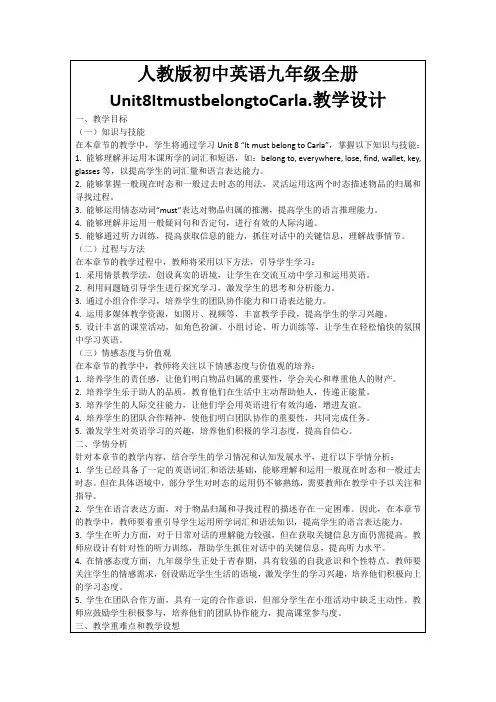

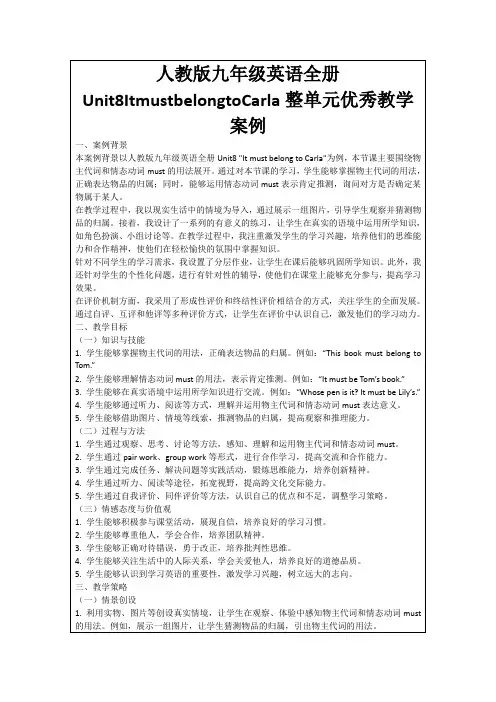
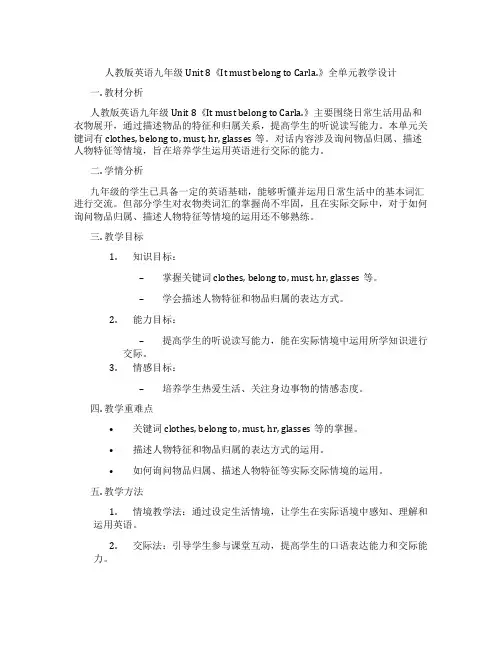
人教版英语九年级Unit 8《It must belong to Carla.》全单元教学设计一. 教材分析人教版英语九年级Unit 8《It must belong to Carla.》主要围绕日常生活用品和衣物展开,通过描述物品的特征和归属关系,提高学生的听说读写能力。
本单元关键词有clothes, belong to, must, hr, glasses等。
对话内容涉及询问物品归属、描述人物特征等情境,旨在培养学生运用英语进行交际的能力。
二. 学情分析九年级的学生已具备一定的英语基础,能够听懂并运用日常生活中的基本词汇进行交流。
但部分学生对衣物类词汇的掌握尚不牢固,且在实际交际中,对于如何询问物品归属、描述人物特征等情境的运用还不够熟练。
三. 教学目标1.知识目标:–掌握关键词clothes, belong to, must, hr, glasses等。
–学会描述人物特征和物品归属的表达方式。
2.能力目标:–提高学生的听说读写能力,能在实际情境中运用所学知识进行交际。
3.情感目标:–培养学生热爱生活、关注身边事物的情感态度。
四. 教学重难点•关键词clothes, belong to, must, hr, glasses等的掌握。
•描述人物特征和物品归属的表达方式的运用。
•如何询问物品归属、描述人物特征等实际交际情境的运用。
五. 教学方法1.情境教学法:通过设定生活情境,让学生在实际语境中感知、理解和运用英语。
2.交际法:引导学生参与课堂互动,提高学生的口语表达能力和交际能力。
3.任务型教学法:通过完成具体任务,培养学生运用英语解决问题的能力。
六. 教学准备1.教师准备:–熟悉教材内容,明确教学目标。
–设计教学活动和任务。
2.学生准备:–预习相关词汇和对话内容。
–准备好日常衣物等物品,用于课堂展示。
七. 教学过程1.导入(5分钟)–教师与学生用英语进行自由交谈,营造轻松的课堂氛围。
–引导学生谈论自己喜欢的衣物,引出本课主题。
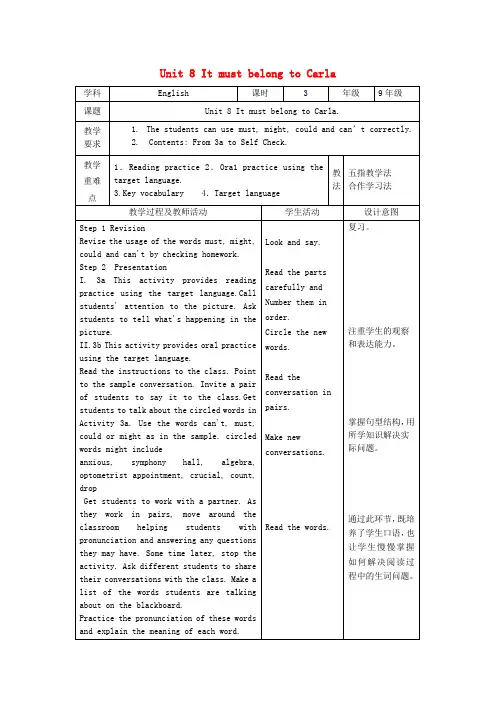

Unit 8 It must belong to Carla〔第1课时〕一、教材分析本单元以“A picnic〞为话题设计教学内容。
以“It must belong to Carla〞为主线围绕谈论某东西属于某人等语言功能展开一系列的任务活动。
本节课主要是属于教学内容的第一局部,要求学会如何进行推测,了解、学会根本句型的应用。
教材内容从根本语言知识到语言综合知识的运用,层层递进,以一种循序渐进的生活化的学习程序,引导学生在做事中有目的的学习语言。
二、三维目标:1、知识目标:本单元通过学习情态动词,学会正确运用must, might, could和can’tbelong to与be在使用中的区别。
2、能力目标:对本单元中的生词做到会读,会写,会用,培养学生听说读写的能力和观察事物的能力。
3、情感目标:培养学生关心他人的情感。
三、教学重点1. 情态动词must,could,might和can’t表推测判断的用法。
2. belong to 短语的应用。
四、教学难点1、情态动词must,could,might和can’t表推测判断的用法。
. 2、 belong to sb 与be sb’s的区别。
五、教学策略:归纳总结情态动词can, may, must表推断的用法,比拟它们的用法区别。
在选择它们进行运用时,要多角度,全方位地思考,根据句子语境明确句子的含义,选择正确的情态动词。
六、教学准备:PPT,一些常见学习用品,录音机七、教学环节1、课堂导入1〕.猜单词,用一些常见实物(碟子、石头、书、CD等)或者用图片、单词卡让学生表达以下单词,先给一名学生看,让他用英语来描述,其他学生猜。
2〕.教学引出本课重点:must,might,could,can’t,belong to1.利用课件中的图片内容进行以下教学活动。
中的教师展示一些学生很熟悉的东西,可以有学生天天带在身边的钥匙、文具盒、笔,发带,或者是其他老师的衣服、饰物。

Unit8 It must belong to Carla.Section A 3a-3cTeaching aims &demands:1. Master the key words: policeman, noise, wolf, happening, uneasy2. Be able to make references.3. Improve students’ reading and comprehensive skills.Teaching process & methods:1.Learn the target language by a reading material.2.Autonomous and cooperative approach.Emotion、Attitude &Values:Cultivate students’ imagination.Teaching key and difficult points:Teaching key points:1.Master the key words and phrase.2.Be able to make inferences using the modal verbs.Teaching difficult points:Learn to use the target language in daily life.Teaching procedures:I.Warm-up1.Greetings.2.Revision.Show some pictures to the class, and ask students to describe them using the target language learned in last class.II. PresentationPresent the new words in the dialogues.A: Do you hear strange noises outside our window?B: Yes, something unusual is happening in our town.A: My father called the policeman, but he couldn’t find anythingstrange.B: Maybe it was a wolf , everyone in our town is feeling uneasy.III. ReadingWork on 3a:(1)Leading in.Ask students if they have ever heard any strange noise at night and how they feel.(2)Tell Ss to read the article and decide which might be the best title.A.A Small and Quiet TownB.Strange Happenings in my townC.Animals in our neighborhood(3)Get students to read the article again and pay attention to thelanguage points1.It used to be very quiet.used to do sth 曾经,过去常常(现在不做了)2.something unusual is happening in our town.不定代词+形容词(定语后置)e.g. 一些重要的事情something important3….but I couldn't see a dog or anything else, either.too “也” 肯定句句末。

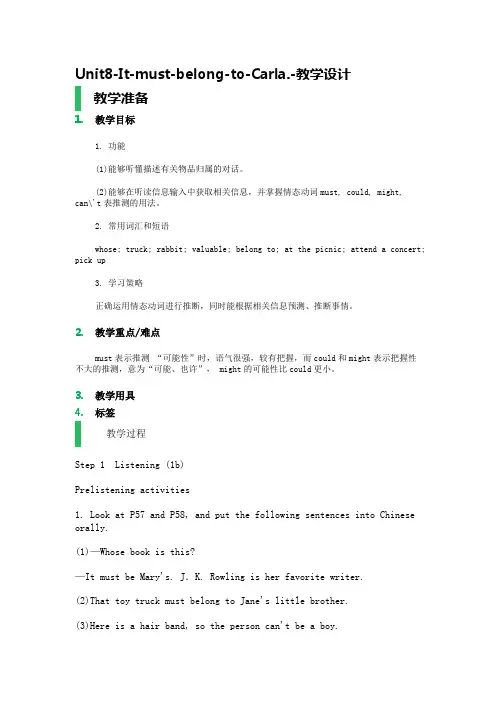
Unit8-It-must-belong-to-Carla.-教学设计教学准备1. 教学目标1. 功能(1)能够听懂描述有关物品归属的对话。
(2)能够在听读信息输入中获取相关信息,并掌握情态动词must, could, might,can\'t表推测的用法。
2. 常用词汇和短语whose; truck; rabbit; valuable; belong to; at the picnic; attend a concert; pick up3. 学习策略正确运用情态动词进行推断,同时能根据相关信息预测、推断事情。
2. 教学重点/难点must表示推测“可能性”时,语气很强,较有把握,而could和might表示把握性不大的推测,意为“可能、也许”, might的可能性比could更小。
3. 教学用具4. 标签教学过程Step 1 Listening (1b)Prelistening activities1. Look at P57 and P58, and put the following sentences into Chinese orally.(1)—Whose book is this?—It must be Mary's. J.K. Rowling is her favorite writer.(2)That toy truck must belong to Jane's little brother.(3)Here is a hair band, so the person can't be a boy.(4)But then the schoolbag could belong to Rita.(5)She's always forgetting things.(6)Then it must be Linda's schoolbag.2. Put the following sentences into English orally, and then write them down without looking at the text.(1)它一定是卡拉的。
Unit8 It must belong to Carla.课文知识点最新详解Section A1. It must belong to Carla.它肯定属于卡拉。
(标题)【解析】belong v 属于= be owned bybelong to +人名(不能用所有格)+代词宾格(不能用物主代词)属于【注】:belong to不能用于进行时态或被动形式,其主语常常是物。
Sth belongs to sb = sth is sb’sThe yellow car belongs to Mr. Smith = The yellow car is Mr. Smith’s.①The sweater belongs to __________ .( Tom)②The T-shirt belongs to___________(she).③Tai Wang __________(属于) China.( ) ④The new car is owned by his father.A .belong to B. belongs to C. is like( ) ⑤Which club do you belong______?A. to B .for C .in D. at【辨析】belong to someone 和be someone’s【相同点】belong to someone 和be someone’s 含义基本相同,都表示“属于某人,归某人所有”,【不同点】用法上的区别:(1)belong to+名词或宾格代词。
(2)be someone’s意思是be + 名词所有格或名词性物主代词The English book must belong to Tom.The English must be Tom’s ( English book).2. He was the only little kid at the picnic.他是野餐中唯一的小孩。
Unit 8 It must belong to Carla(第4课时)说课稿一. 教材分析《Unit 8 It must belong to Carla》是人教版(新目标)初中英语教材的一个单元,主要围绕着“推测”这一主题展开。
通过本单元的学习,学生能够掌握一般过去时的被动语态,学会使用“must have done”和“can’t have done”等结构来表达对过去事情的推测,同时提高在日常生活中用英语进行交流的能力。
本单元包括两个部分,第一部分是课文阅读,讲述了Carla丢失了钥匙,通过观察和推测找到了失主的有趣故事;第二部分是听说练习,通过不同的场景让学生练习使用一般过去时的被动语态进行交流。
二. 学情分析考虑到我所教授的学生是初中生,他们的英语水平已经达到了一定的程度,具备一定的听、说、读、写能力。
在此基础上,他们需要通过大量的实践和练习来进一步提高自己的语言运用能力。
同时,他们对于新鲜事物充满好奇,善于发现和总结规律,因此在教学过程中,我会引导他们通过观察、思考、交流和总结来掌握本节课的知识点。
三. 说教学目标根据课程标准和学生的实际情况,我制定了以下教学目标:1.知识目标:学生能够掌握一般过去时的被动语态,理解并运用“musthave done”和“can’t have done”等结构表达对过去事情的推测。
2.能力目标:学生能够在日常交流中运用所学知识,提高自己的英语表达能力。
3.情感目标:通过本节课的学习,学生能够培养合作、探究和创新的精神,提高自己对英语学习的兴趣。
四. 说教学重难点1.教学重点:学生能够掌握一般过去时的被动语态,学会使用“musthave done”和“can’t have done”等结构表达对过去事情的推测。
2.教学难点:学生能够灵活运用所学知识,在实际交流中准确地表达自己的观点。
五. 说教学方法与手段为了实现本节课的教学目标,我采用了以下教学方法和手段:1.任务型教学法:通过设定各种真实的任务,让学生在完成任务的过程中运用所学知识,提高自己的语言能力。
Unit 8 It must belong to Carla.Section A 1 (1a-2d)一、教学目标:1. 语言知识目标:1)能掌握以下单词:truck, pic nic, whose, pin k, rabbit, magaz ine能掌握以下句型:①The person must go to our school.②一Whose book is this?—It must be Mary's. /It must bel ong to Mary.2)能够用情态动词表推测.2•情感态度价值观目标:让学生根据已有事实推测可能性。
二、教学重难点1. 教学重点:1)掌握本课时中出现的生词truck, pic nic, volleyball, whose, pi nk, rabbit, valuable, somebody, an ybody2)学会描述表示物品所属提问和回答:—Whose book is this?—It must be Mary's.2. 教学难点:Whose ...... is this?句型三、教学过程I . Finish 1a.1. Look at the chart in 1a, the n discuss with your group mates. Try to fill in the chartwith words to describe people.2. Let some Ss say their an swers. Let other Ss add more.n. PresentationPrese nt some pictures about the new words, the n lear n.川.Listening1. T: Here are some things belonging to those five people. Listen and match each pers on with a thing and a reas on.2. Play the recordi ng for the Ss to liste n.3. Ss liste n and try to match the each pers on with a thing and a reas on.4. Check the an swers.IV.Pair work1. Look at the conv ersati on in 1c and make conv ersati ons in pairs.2. Let some pairs ask and an swer in pairs.e.g. A: Whose book is this?B: It must be Mary's. J.K. Rowli ng is her favourite writer.V.ListeningWork on 2a:T: Bob and Anna found a schoolbag at the park. Liste n and write dow n the things in the schoolbag.1. Look at the chart in 2a.2. Play the record ing for the Ss to liste n and check the words they hear.3. Play the record ing aga in to check the an swers.Work on 2b:1. Let Ss read the senten ces below. Expla in some main senten ces for the Ss. Makesure they know what to do.2. Play the record ing for the Ss to fill in the bla nks with the right words.3. Play the record ing aga in to check the an swers.Summary:表推测的形容词的用法W .Pair work1. Tell Ss to make conv ersatio ns about the schoolbag using the in formatio n in 2a.2. Let some pairs act out their conv ersati ons before the class.e.g. A: Look! There's a schoolbag here.B: What's in side?A: There ' s asTirt, …VD. Role-play1. Read the con versati ons and Let Ss read after the teacher.2. Expla in some new words and main poi nts in the conv ersati on.3. Ask Ss to role-play the con versati on in groups.VIII. Language points1. It must bel ong to Carla.belong to意为属于”它一般不用于进行时态和被动语态。
Unit8It must belong to Carla.Period1词汇学习课【学习目标】1.能够正确拼、读、写whose,attend,purpose,at the same time等词汇。
2.通过自主学习与小组合作,掌握词汇的拼读记忆规则和相关的词型转化。
3.能够与他人相互学习,相互帮助,提升自己的英语水平。
【重点】:noise,express,energy等词汇变换。
【难点】:whose,noise等词汇的运用。
1.Read after the tape player together,correct your pronunciation.2.Prepare for your word reading in groups,then have a competition,the others give them marks.3.Look at some pictures and say out the new words.4.Learn the forms of the words.5.Summary:1.掌握了本单元重点词noise,express,energy等的词形变化。
2.通过对单词的合理拓展,注重新旧单词的区别和联系,更好的掌握了whose,sleepy等单词。
6.Homework:1.疯狂朗读记忆单词和相关词汇变化,准备第二天单词检测。
2.完成Section A预习案自我反思:Period2Section A听说课(1b---2d)【学习目标】1.运用情态动词表推测的用法进行交际练习。
2.熟读Section A重点短语句子。
3.根据传达的信息作出合理推断。
【重点】:体会情态动词表推测的用法。
1.Go through the study-guide2.Lead-in:Watch a video and listen to a song:Whose Puppy is this?3.After listening to the song and answer the question:Whose dress is this?S s:It's Min's mom's.T:It must be Min's mom's,because I heard it just now.T:Make inferences(推测):must---really true(肯定--一定);might/could…possibly true(有可能--也许);can’t…not true(不可能)4.Guessing game:1)Who is he?2)Whose car is this?He can’t be_______.It might/could be________.He could/might be_______.It can’t be__________.He must be_______.It must be___________.3)What does he/she do?He/She could/might be a/an_____________.4)What is the panda doing?It might/could be doing...5.Look and learn:Whose notebook is this?It may belong to…/must belong to…/can’t belong to…/is.../isn't.....6.Pair work7.(1a)Look at the picture.Write the things in the correct columns in the chart.8.(1b)Listen and match each person with a thing and a reason.9.(1c)Read it together.10.Summary:1.掌握了belong to与be的用法区别。
导学案教师: 学生: 年级:日期: 星期: 时段:课题第Unit8 It must belong to Carla考点分析:unit8核心语法之情态动词表示推测的用法学习目标与考点分析情态动词表推测的用法;表达某人的想法与观点学习重点学习方法学习内容与过程课文解读Section BStonehenge ---- Can Anyone Explain Why It Is There?Stonehenge, a rock circle, is not only one of Britain’s most famous historical places but also one of its greatest mysteries. Every year it receives more than 750,000 visitors. People like to go to this place especially in June as they want to see the sun rising on the longest day of the year.For many years, historians believed Stonehenge was a temple where ancient leaders tried to communicate with the gods. However, historian Paul Stoker thinks this can’t be true because Stonehenge was built so many centuries ago. “The leaders arrived in England much later,” he points out.Another popular idea is that Stonehenge might be a kind of calendar. The large stones were put together in a certain way. On midsummer’s morning, the sun shines directly into the center of the stones. Other people believe the stones have a medical purpose. They think the stones can prevent illness and keep people healthy. “As you walk there, you can feel the energy from your feet moving up your body,” said one visitor. No one is sure what Stonehenge was used for, but most agree that the position of the stones must be for a special purpose. Some think it might be a burial place, or a place to honor ancestors. Others think it was built to celebrate a victory over an enemy.Stonehenge was built slowly over a long period of time. Most historians believe it must be almost 5,000 years old. One of the greatest mysteries is how it was built because the stones are so big and heavy. In 2001, a group of English volunteers tried to build another Stonehenge, but th ey couldn’t. “We don’treally know who built Stonehenge,” says Paul Stoker. “And perhaps we might never know, but we do know they must have been hardworking ---- and great planners!”要点详解1.Why do you think the man is running?本句由“疑问词+do you think+其他”构成的特殊疑问句。
在此结构中,如果特殊疑问词在句中作主语,特殊疑问句语序不需要变化;如果特殊疑问词在句中不作主语,特殊疑问句用陈述句语序。
Who do you think is the tallest in your class?Where do you think we should go for a holiday?2.He could be running for exercise.could be running 情态动词+be+doing 结构,表示推测正在进行或发生的动作I think he could be watching TV at home.3. No, he is wearing a suit.suit 此处用作可数名词,意为“西服;套装”Today my teacher wears a suit.suit可作动词,适合,适宜suit sb fine 很适合某人suitable adj 适合的短语be suitable forI think blue clothes suit her very fine.The story is not suitable for young children.4.He might be running to catch a bus to work.catch 赶上词组catch up with 赶上某人catch 的一词多义:catch the ball catch the bus catch the chief catch a cold5.expressing a difference 表达不同之处express v 表达,表示(思想和感情)express…to sb. 对某人表达。
I find it difficult to express my meaning. She expressed her thanks to us.expression 为express的名词形式表达,表示,表达方式I sent them flowers as an expression of thanks.6. Stonehenge, a rock circle, is not only one of Britain’s most famous historical places but also one of its greatest mysteries.circle 圆圈,也可表示有共同兴趣爱好或职业等的“阶层;圈子;界”The children stood in a circle around the fire. He is well-known in theatrical circles.circle v Please circle the correct answers.not only….but also….须遵循的三原则:①并列原则:并列连词,连接两个并列成分,其中also 可省略②主谓一致原则:连接两个并列主语时,谓语动词在人称和数上要与but also后的主语保持一致③倒装原则:连接两个分句时,not only置于句首,表示强调,其引导的句子要用部分倒装,即将谓语动词的一部分(如情态动词、助动词等)放在主语前面,而but also后的句子用正常语序Not only he but also I am interested in pop music.Not only do I feel good about helping people, but also I get to spend time doing what I love to do.7. Every year it receives more than 750,000 visitors.receive 及物动词,此句中意为:接待,招待;receive 还可表示:接到,收到,与get同义,后可接介词fromThey are very glad to have the opportunity to receive the guest.I received a letter from my mother.receive与acceptreceive 收到,强调客观上收到这一事实,不表明是否愿意接受此物accept 接受,主动地或自愿地接受,带有满意、同意、答应、认可等意味,其反义词为refuseI received his invitation to the party yesterday, but I refused to accept it.8. Other people believe the stones have a medical purpose.medical adj 医疗的,医学的名词形式是medicineHe is a medical student. Have you take your medicine this morning?purpose n 目的,目标,意图常与of连用常用短语on purpose 故意地What was the purpose of his visit?He came here with/for the purpose of seeing his family.She did it on purpose, of course.9. They think the stones can prevent illness and keep people healthy.prevent 阻止,阻挠相当于stop 常用结构prevent sb ( from ) doing sthCould people prevent these accidents? Mother prevents/stops me (from) eating too many candies. 注意:from 在主动语态中可以省略,但在被动语态中不可省略He was prevented/ stopped from playing computer games.10. As you walk there, you can feel the energy from your feet move up your body..energy 精力,力量形容词形式为energetic 精力充沛的Young people usually have more energy than the old. He is an energetic boy.单元语法情态动词表示推测的用法1.概述:一般来说,英语中可用于表示推测或表达可能性的情态动词有can, could, may, might, must must表示很大的可能性,一般只用于肯定句,意为:肯定,一定,必定eg: You must be tired after the long journey.might 在表达可能性时语气最弱。